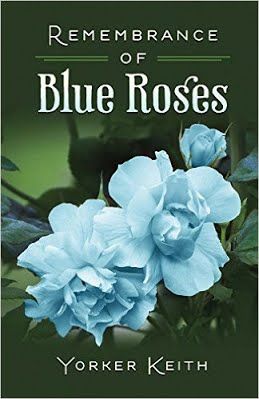Remembrance of Blue Roses Promo Blitz
Literary Fiction
Date Published: April 2016
Remembrance of Blue Roses follows a man and a married couple in New York City, whose intricate relationship oscillates among friendship, love, love-triangle, and even obsession. Its romantic ambience is interwoven with classical music, opera, art, family legend, and international affairs, illuminating the lives of international civil servants at the United Nations and the UN peacekeeping mission in Sarajevo, and those with direct experience of the Israel-Palestinian conflict and the Holocaust.
Mark, the narrator and an American, works for the United Nations in New York as a personnel officer; his friend, Hans, German, also works for the UN as an economist; and Yukari, Japanese and Hans’s wife, is a professional violinist. One day Mark encounters Hans and Yukari in a museum. As Hans enjoys opera singing and Mark is into painting, the three foster their friendship through classical music, opera, and art. Mark resists feeling drawn to his friend’s wife. One evening over dinner, they discover that their families were acquainted generations ago. This bonds them together. During the summer, inspired by the beauty of Yukari in her light blue dress at the UN garden, Hans and Mark secretly plant blue roses there for Yukari. The blue roses later blossom sumptuously. The three enjoy their blue roses, the symbol of their friendship and bond.
The story becomes complicated by the involvement of two other women: Mark’s ex-wife, Francine, a Swiss, who is remarried to another of Mark’s friends in the UN, Shem Tov, an Israeli; and Mark’s high school sweetheart, Jane, to whom he was briefly engaged. Francine encourages Mark to be happy with Yukari, while Jane now wants to marry Mark. Yukari becomes pregnant with Hans’s child and happily settles into her role as expectant mother. Mark, Hans, and Yukari celebrate New Year’s Eve at the height of their friendship and happiness. … Then a series of tragedies shatters their joy and alters their future forever.
... Then a series of tragedies shatters their joy and alters their future forever.
Praise for Remembrance of Blue Roses:
"A skillful tale that explores relationship nuances and redemption." -- Kirkus Reviews
"Yorker Keith’s Remembrance of Blue Roses is a slow-burning, passionate literary novel that speaks to the romantic in all of us. ... A precisely-written, well-crafted literary work that illuminates the many facets of love, obsession and, ultimately, redemption." -- Chanticleer Book Reviews
"A deftly crafted, multi-layered, compelling read from beginning to end, Remembrance of Blue Roses establishes novelist Yorker Keith as an extraordinarily gifted storyteller." -- Midwest Book Review
"Readers who enjoy a sophisticated and well-written book about the complexity of human relationship will definitely enjoy Remembrance of Blue Roses." -- Readers' Favorite
Excerpt
I have heard a wise man say that love is a form of friendship, and friendship a form of love; the line between the two is misty. I happen to know that this holds true because I have roamed that misty line. Time has passed since then, but I cherish the memory of the blue roses in grace and perpetuity — our blue roses. It all began with a fortuitous encounter.
* * *
On a fine day in early April 1999, I was sketching in the sculpture court at the Metropolitan Museum of Art. I felt hesitant working in such a public space, but this was a homework assignment for the art class I was taking. The object of my sketch was a sculpture of an adorable young woman, a nude, reclining on a moss-covered rock surrounded by an abundance of flowers. The smooth texture of the white marble sensually expressed her lively body, which shone with bright sunlight beneath the glass ceiling of the court.
My drawing materials were simple, just a number 2 pencil, an eraser, and a sheet of heavy white drawing paper. The assignment was to capture the skin of a figure in as much detail as possible. I had almost completed sketching the woman’s body and was working on the rock and flowers. I was not doing badly, I thought, for a small crowd of museum visitors had gathered around me, showing approving faces and nods.
“Ah, this is excellent!” one man exclaimed.
I recognized the voice and turned to see Hans Schmidt, standing amid the crowd wearing a big grin.
“What a surprise!” he continued. “I didn’t know you had such an artistic talent, Mark. How are you?” He came forward and firmly shook my hand.
I greeted him, then pointed to my drawing. “I’ve been working on this for a while. I wasn’t sure how it would come out. But it’s coming along all right, I guess.”
“I don’t know much about drawing, but this looks great.” He gestured enthusiastically to a young woman next to him. “What do you think?”
“It’s pretty.” Her voice sounded like a bell.
“This is Yukari, my wife.” He guided her toward me, his hand lingering at the small of her back.
I swallowed. I knew Hans was married, but this was my first time to meet his wife. Hans’s wife is Japanese? How lovely she is. Hans, you devil, you’re a lucky man!
“Pleased to meet you.” I gently shook her small refined hand. “I’m Mark Sanders. Hans and I are good friends.”
Hans’s wife appeared to be in her late thirties, or late twenties? I could hardly tell, because Japanese women often looked much younger than their age. She was willowy, of medium height, with a fine complexion, dark eyes, straight nose, and shiny dark brown hair that hung to her shoulders. For a Japanese woman, she had a touch of a Western woman’s body, the round breasts and a curvy waist. Despite her conservative dress, she reminded me of the nude I was sketching — though I quickly banished the thought.
She gazed directly into my eyes with keen curiosity. “Do you come here often to sketch? It’s really nice.”
“Well, yes,” I answered, “I visit this museum often. But to sketch? No, this is the first time. You know what? It’s so embarrassing.”
I dabbed some sweat from my forehead. We three burst out laughing.
“Hans, I’m almost done. Can you come back in ten minutes or so?” I said. “Then we could go to the terrace for a cup of coffee.”
“Sounds terrific,” said Hans. “We’ll be walking around the sculpture court. When you’re done, just join us.”
Hans took Yukari’s arm and started moving leisurely toward other sculptures. She smiled at me and went along with him. Hans tried to hold her closely at her waist, but she discretely slipped away. I didn’t understand what it meant. I presumed that as a Japanese woman she was timid to show open affection.
I hastily added finishing touches to the figure, rock, and flowers. Since the figure had been almost completed, the rest went quickly and easily — or so I felt after having seen Hans and Yukari.
* * *
I had known Hans for some time because both he and I worked at the United Nations New York Headquarters as international civil servants. He was German, aged forty-two, tall and slim, with blond hair, high forehead, and grey eyes. He had a Ph.D. in economics from the University of California at Berkeley, and worked as an Economic Affairs Officer in the Department of Economic and Social Affairs of the Secretariat, which was the administrative body of the UN. His job there was to maintain and operate a global econometric modeling system, called EGlobe.
We had originally met in a French language class. Being at the UN, we were required to be proficient in at least two of its six official languages: Arabic, Chinese, English, French, Russian, and Spanish. In my case, I added French to my native English. My French was hardly adequate, though, so I was working my way through the seven-level French program.
In level six I met Hans, who had just started the program from that level. We ate lunch often together in the cafeteria and practiced our French. His grasp of the language was much better than mine. Also, since he used computers heavily for his work, and since I had a good friend, Shem Tov Lancry, an Israeli, in the Information Technology Services Division of the Department of Management, I introduced them, so Hans was able to receive technical advice from Shem Tov.
I packed up my drawing materials, and we three went to the balcony above the Great Hall of the museum, where drinks and desserts were served while musicians played chamber music. We each ordered a glass of red wine.
About the Author
Yorker Keith lives in Manhattan, New York City. He loves literature, theatre, classical music, opera, and art. He holds an MFA in creative writing from The New School. His literary works have been recognized four times in the William Faulkner - William Wisdom Creative Writing Competition as a finalist or a semifinalist.
Contact Links
Purchase Links






Comments
Post a Comment